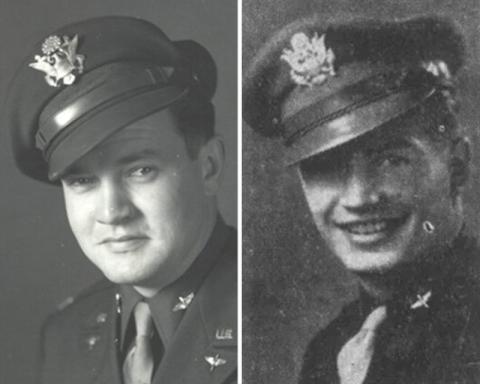Wyoming Flyboys in “Masters of the Air”
By Marcus Holscher, American Heritage Center, University of Wyoming
Wyoming fans of Masters of the Air, a new television series on Apple TV+ about U.S. Army Air Force combat over Europe in World War II, may have been surprised in the first episode to hear Austin Butler’s character, Gale Cleven, introduce himself as being from Casper. He points to Casper on a map. In a later episode, a second Wyoming character shows up, George Niethammer, played by Josh Dylan.

Both men in fact were students at the University of Wyoming and college friends before the war. In this post, we’ll take a closer look at them and their connection with Wyoming and the University of Wyoming (UW).
Gale Cleven was born in Lemmon, South Dakota, Dec. 27, 1918. As a child, he and his family moved to Wyoming for his father’s work in the oil fields. Cleven attended high school in Midwest and began attending UW around 1937, first appearing in the 1940/1941 Wyo yearbook as a junior studying mathematics. In the summers, he worked as a roughneck in the oil fields around Casper to pay for school.
Cleven seems to have been quite active in student life and appears as well to have had an early interest in military service; he is reported in The Sheridan Press of Dec. 4, 1938, as being a first alternate choice for one of Wyoming’s appointment slots for the service academies.
George Niethammer was born in Red Lodge, Montana, Sept. 12, 1919. He graduated from Natrona County High School in 1937 and went on to UW afterwards. Like Cleven, Niethammer was active on campus. He was elected president of the freshman class in 1937 and was involved in a committee to investigate a subpar whitewashing of W Hill. He ran track and won low hurdles at a meet against Denver in April 1939.
But in October of that year, UW’s student newspaper the Branding Iron reports that another student had been elected to class president; Niethammer was not returning to school. His draft registration card dated October 1940 listed him as living in Casper and employed at his family’s meatpacking plant. He was a member of the Wyoming National Guard before the war, and after activation for wartime service at some point transferred to the Army Air Corps for training as a bomber pilot.
Flying B-17 or B-24 heavy bombers, the crews of the U.S. Army air forces flew missions over German-occupied Europe to bomb such strategic targets as submarine bases, industrial factories, railroad yards, etc. to disrupt the German economy and war machine and hasten the end of the war. While the British RAF flew at night, the USAAF flew in the daytime, suffering heavy casualties from anti-aircraft artillery and fighter attacks.
Cleven piloted a B-17 in combat; Niethammer piloted a B-24. Niethammer was quoted in the Branding Iron May 4, 1944, recounting in a letter home how he was shot down and had to ditch in the Adriatic Sea—and was rescued.
Cleven and his crew were shot down Oct. 8, 1943, were captured, and became prisoners of war. Niethammer and his crew were shot down again in May 1944 and crash-landed in Germany, also becoming prisoners of war. The two friends were reunited at the POW camp Stalag Luft III in what’s now Poland, a German prisoner of war camp for downed allied airmen. As the Soviet Red Army advanced westward, the Germans force marched prisoners west to be interned in different camps. During one such march, Cleven and Niethammer escaped—and were separated.
Cleven made it successfully to Allied lines. He was repatriated to England to continue service, but did not know what had happened to Niethammer After the war, Cleven resumed his studies at UW, graduating in 1946 and returning in 1956 for a master’s degree. He remained in the Air Force throughout the Korean and Vietnam wars, finally retiring from the service and holding a range of other jobs, including in aeronautics and as the president of Webber College in Florida. He died Nov. 17, 2006, in Sheridan.
Tragically, Niethammer was shot and killed during his escape attempt. His remains were located in 1949. Niethammer is buried at the Ardennes American Cemetery in Liège, Belgium.
Gale Cleven was a pallbearer at his memorial service in Casper.
[Editor’s note: Special thanks to the author and to UW’s American Heritage Center for this post, an earlier version of which was posted April 1, 2024. Holscher works at the Toppan Rare Book Library at the AHC.]
Sources
- Ancestry.com. U.S., School Yearbooks, 1900-2016 [online database]. Lehi, UT, USA: Ancestry.com Operations, Inc., 2010.
- Ancestry.com. U.S., World War II Draft Cards Young Men, 1940-1947 [online database]. Lehi, UT, USA: Ancestry.com Operations, Inc., 2011.
- Memorial page for Col. Gale Winston “Buck” Cleven (27 Dec 1918–17 Nov 2006), Find a Grave, database and images, Find a Grave Memorial ID 18089976, citing Santa Fe National Cemetery, Santa Fe, Santa Fe County, New Mexico, USA; Maintained by Paula and Dale (contributor 46489742), accessed March 29, 2024.
- American Battle Monuments Commission website.
- Miller, Donald. Masters of the Air. New York: Simon and Schuster, 2006.
- WYO Yearbook, 1940/41.
- Wyoming Digital Newspaper Collection.
Read Aerials to Zephyrs: A Brief History of the Casper Army Air Base
